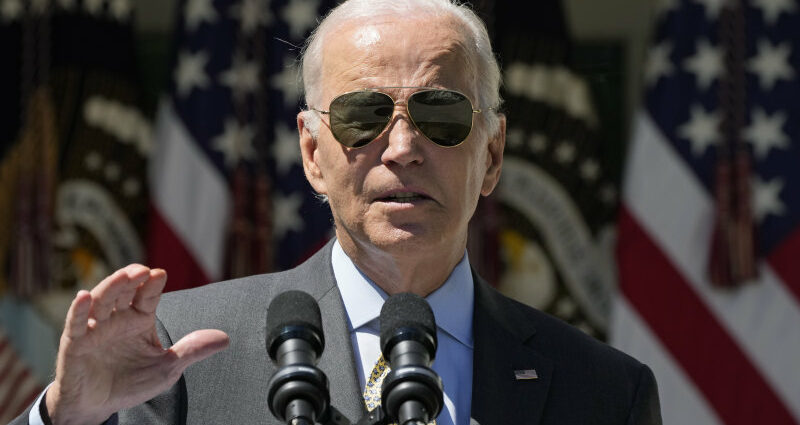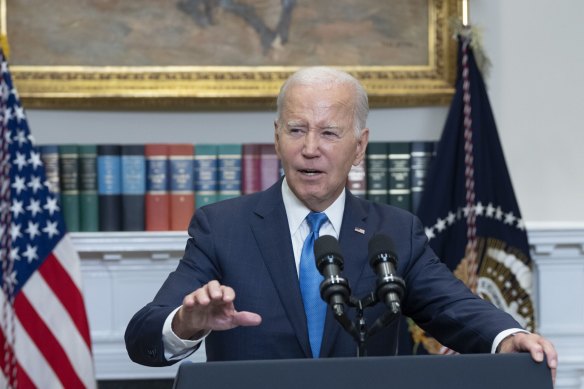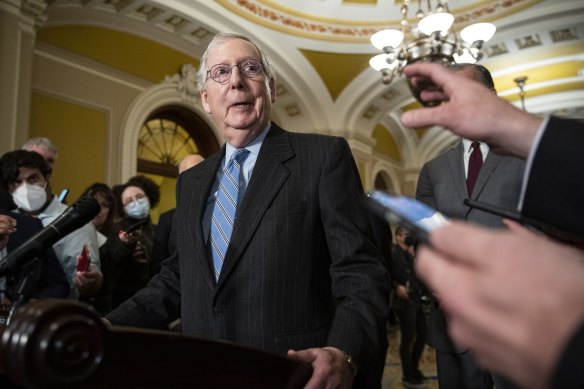Save articles for later
Add articles to your saved list and come back to them any time.
Another bout of internecine warfare within the Republicans in Congress is threatening to shut down the US government in less than a fortnight, only months after the US narrowly averted a default on its debts.
On Tuesday, House speaker Kevin McCarthy was forced to postpone a procedural vote on a measure that would have provided stop-gap funding for the government, extending the deadline for an agreement for the funding for the US 2023-24 fiscal year from September 30 by a month.
A shutdown would force the Biden administration to shut down many of its agencies and services and stand down non-essential federal workers without pay until a funding deal can be struck.Credit: Bloomberg
About a dozen hard-right Republicans have frustrated McCarthy’s attempt to pass a bill that would, because it would impose an 8 per cent cut to non-defence discretionary spending, included Trump-era border security measures, excluded funding for Ukraine and attacked “wokeism” in the military, be most unlikely to be passed by the Democrat-controlled Senate.
Congress needs to pass 12 appropriation bills by September 30 if the US is to avoid a shutdown that would force the Biden administration to shut down many of its agencies and services and stand down non-essential federal workers without pay until a funding deal can be struck.
The last shutdown, during the Trump administration in 2018-19 – the longest of the 14 in US history at 35 days – was disruptive but caused no lasting economic harm, with the Congressional Budget Office concluding that the net cost to the US economy was $US3 billion ($4.7 billion), with the initial loss of GDP largely recovered once the funding was restored.
Goldman Sachs has estimated that a shutdown next month would, because social welfare payments would continue and there is no threat to interest or principal payments on US government debt, would initially wipe out about 0.2 percentage points of economic growth each week but, as occurred in the last shutdown, growth would rebound by a similar amount.
Previous experience also says that shutdowns have little impact on financial markets, although Goldman did say that a prolonged shutdown might cause the Federal Reserve Board (which has been meeting this week amid expectations it will leave US rates untouched) to also keep its monetary policies on hold at its November meeting.
Nevertheless, the internal dysfunction within the Republican House’s factions (sometimes described as the “five families,” which references the five Mafia families that operate in New York) underscores the wider dysfunction of America’s political system that led to the Fitch credit rating agency downgrading US government debt earlier this year after the confrontation over the US debt ceiling.
The last-minute deal that McCarthy struck with Joe Biden in May to avert a default on US government debt provides the background for the fracturing of the Republican House factions over the appropriation bills.
McCarthy agreed to a two-year suspending of the $US31.4 trillion debt ceiling in exchange for a pledge by Biden that non-defence spending would be flat in 2023-24 and increase only one per cent in 2025, infuriating the hard line fiscal conservatives in the House Freedom Caucus and the motley MAGA crew who oppose anything and everything the Democrats put forward.
Senate Minority Leader Mitch McConnell says the negotiations over the funding of the world’s most powerful government are “a pretty big mess.”Credit: Bloomberg
Under threat from the conservatives in his own party, who are threatening to remove him as Speaker, McCarthy sought to appease them and gain their support for the stop gap funding bill by initiating an impeachment inquiry into Biden. It self-evidently didn’t work.
McCarthy’s problem, and America’s problem, is that the uneasy alliance of genuine fiscal conservatives and Trump’s MAGA loyalists want to regard the deal he struck with Biden as a ceiling on spending rather than a floor.
They want to slash non-defence spending and to gut Biden’s ambitious social, environmental and industrial programs, as well as attack his “woke” policies and promote their own agendas on abortion, vaccines, border security, funding for military equipment for Ukraine and the funding of the prosecutions of Donald Trump.
The procedural vote on a $US826 billion defence spending bill, which would normally be supported wholeheartedly by Republicans – it should have been the easiest of the appropriation bills to get through the House – was yanked by McCarthy because the recalcitrant members within his partyroom wanted to attach a grab bag of unrelated right-wing measures like restrictions to abortion access, transgender medical care, diversity and inclusion programs and affirmative action.
Future administrations are going to have to grapple with the question of how to make America’s finances more stable and sustainable.
Even if stripped of those measures the bill, because of the proposed major cuts to non-defence spending, would be unlikely to be supported by a majority of the Senate and, even if it were, it would merely delay rather than resolve the impasse between the factions within the Republicans and the gulf between what the hardliners want and what the Democrats in the Senate would accept.
A one-month reprieve from a shutdown would merely shift the combustible moment from October 1 to November 1.
As the Republican leader in the Senate, Mitch McConnell, has said, the negotiations over the funding of the world’s most powerful government are “a pretty big mess.”
The deal McCarthy agreed with Biden would, if delivered on, trim about $US2.6 trillion from the US government deficits over the next decade, albeit that the impact in the 2023-24 financial would be only about $US120 billion.
The last shutdown came during the Trump administration and lasted 35 days.Credit: Bloomberg
An expected weakening of what has been quite robust US economic growth and historically high interest rates, however, are expected to see America’s debt-to-GDP ratio rise over the next few years. The debt ceiling before the Biden-McCarthy pact was $US3.14 trillion. US gross debt surpassed $US33 trillion this week.
Even with Biden’s spending cuts, unless there is stronger US economic growth, without significant inflation and therefore with lower interest rates, the debt is forecast to be as much as $US50 trillion by the end of the decade.
The more rational fiscal conservatives do have a point, although it was the Republican Trump administration that added $US7.8 trillion to the national debt, with his unfunded $US1.9 trillion of tax cuts for the wealthy a major pre-pandemic contributor.
Future administrations are going to have to grapple with the question of how to make America’s finances more stable and sustainable.
In the meantime, the internal dysfunction of the House Republicans and the breadth of the degrees of policy differences between the Republicans and Democrats are again threatening the ability of the US government to fund itself and function.
The Business Briefing newsletter delivers major stories, exclusive coverage and expert opinion. Sign up to get it every weekday morning.
Most Viewed in Business
From our partners
Source: Read Full Article




